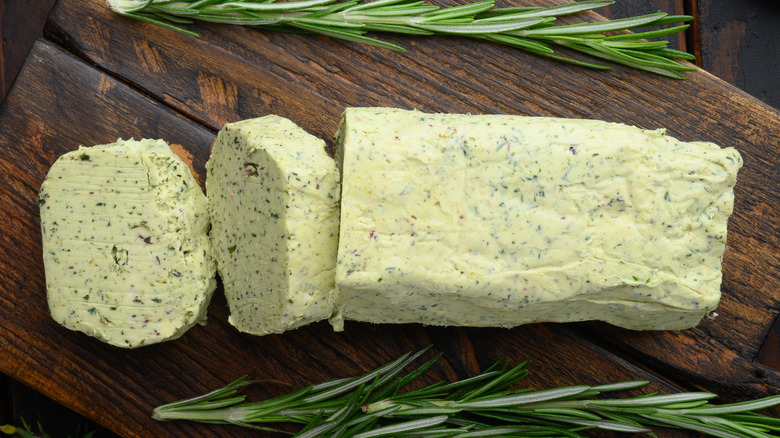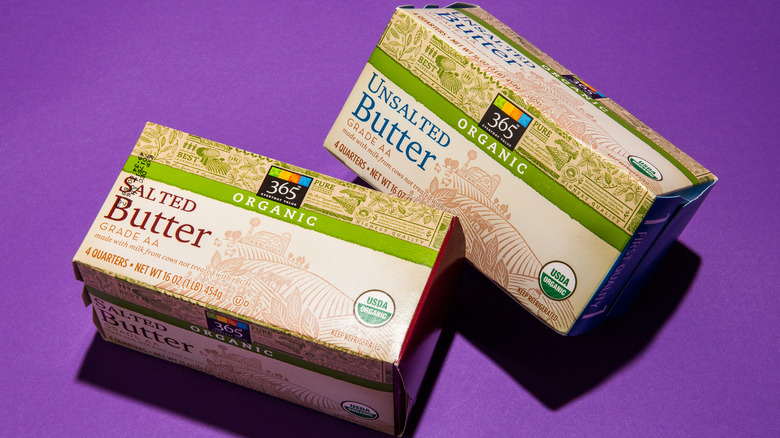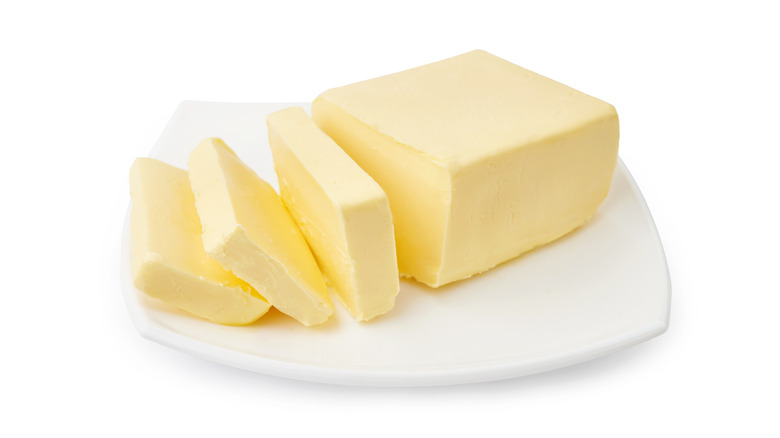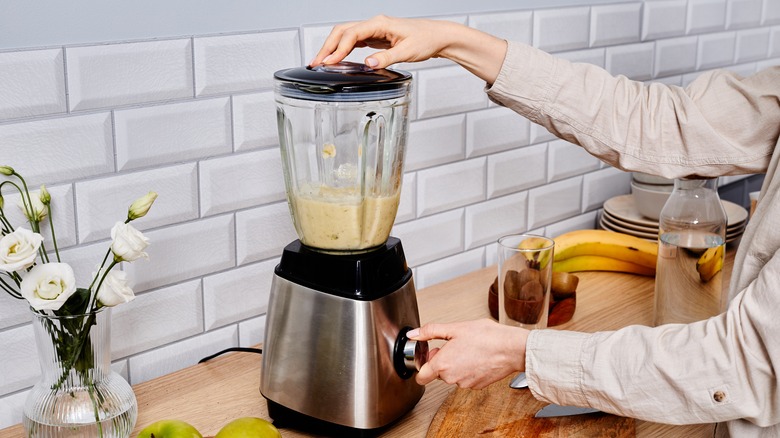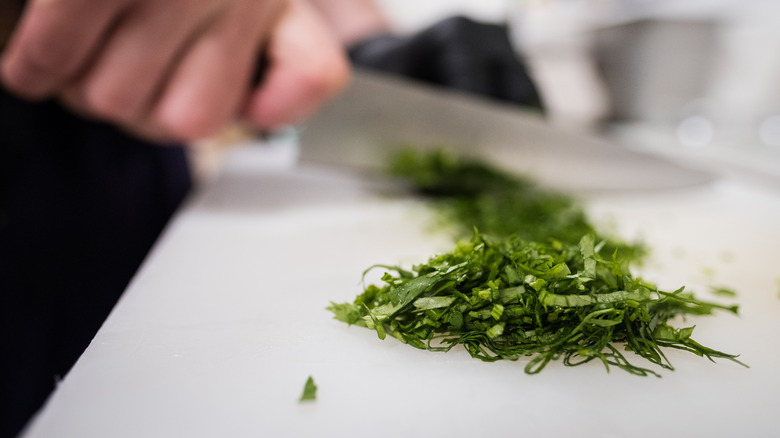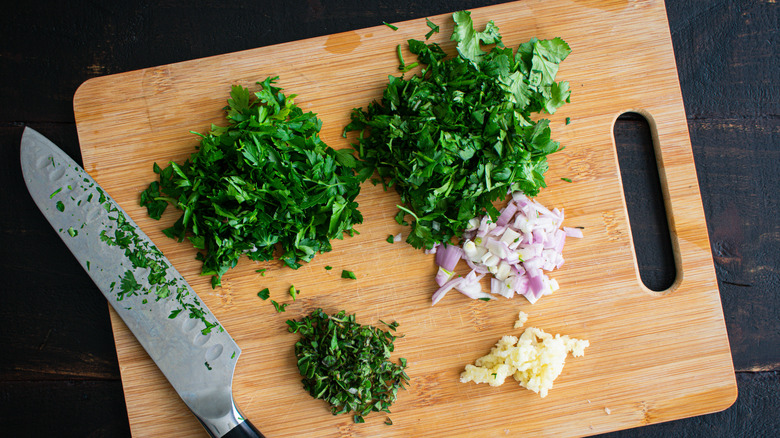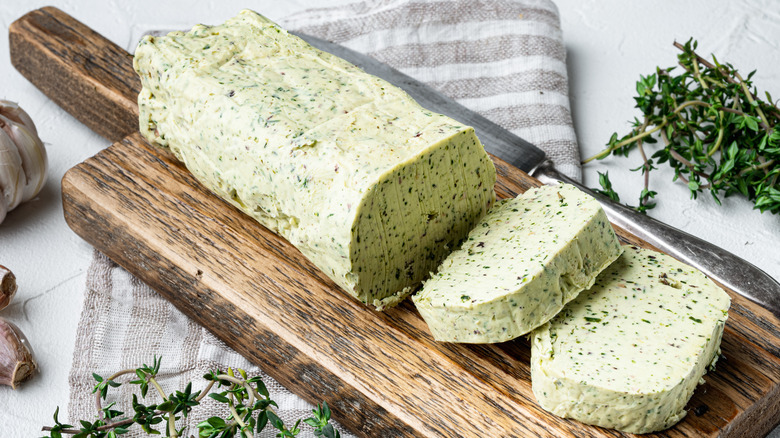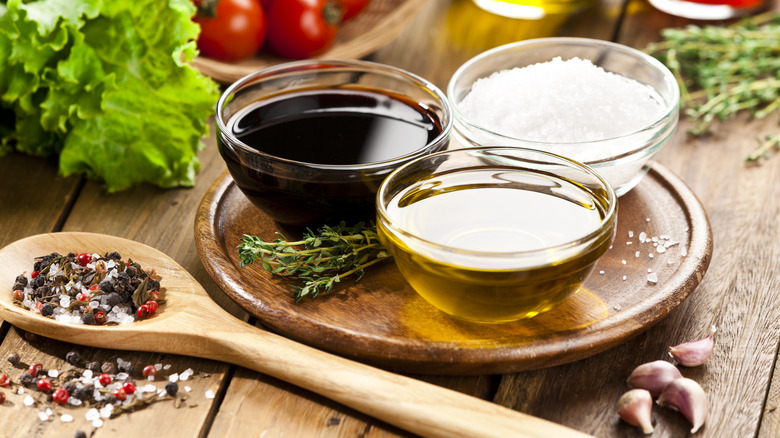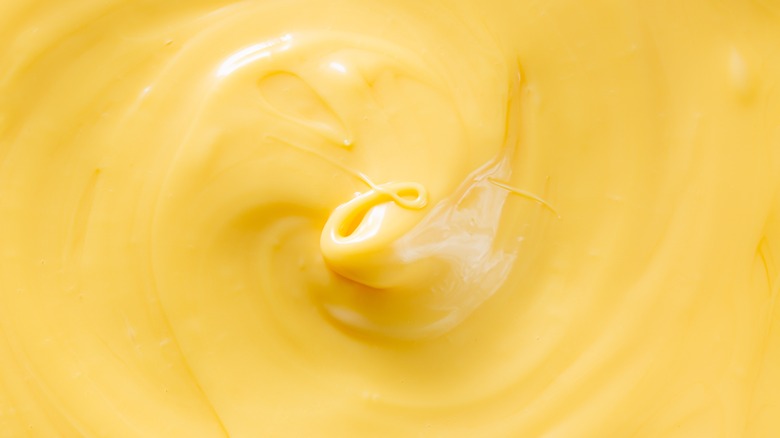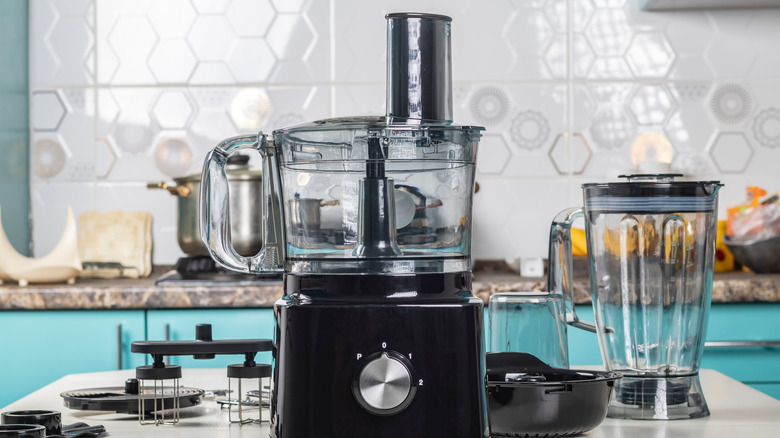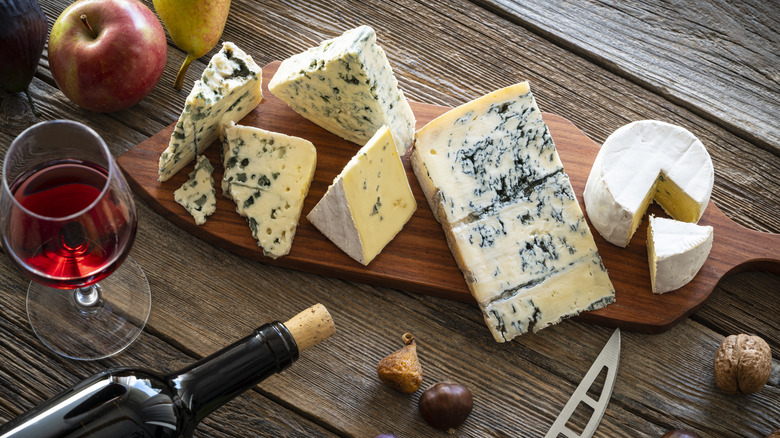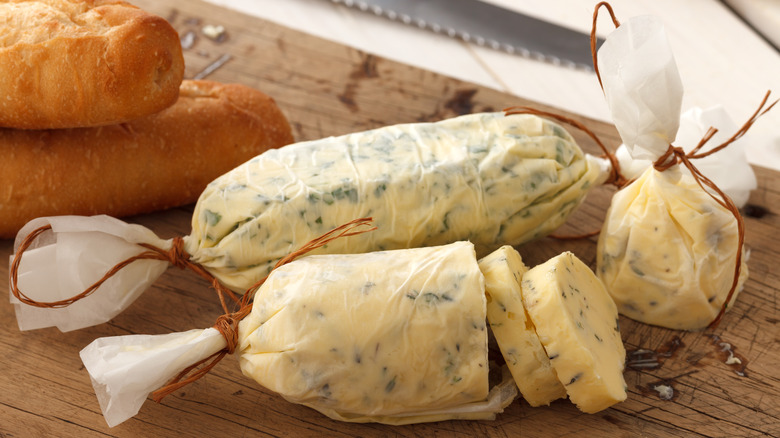11 Mistakes To Avoid When Making Compound Butter
Oh, the joy of butter. Our creamy comrade and silky savant. When shy flavors need a bit more convincing to come out to party, butter is the fun friend that you can never say no to. In a world made better by buttery goodness, it's hard to imagine living without it.
Aside from being the arbiter of flavor, butter's neutral taste makes it extremely versatile. Rather than overwhelming ingredients, it's best in a supporting role, coaxing out the hidden potential each ingredient has to offer. Its neutral taste is also the same quality which makes it excellent and easy for customization. From fresh herbs and savory liquids to dried fruit and peppers, there's no shortage of compound butter combinations you can create. Those looking for a bit of sweetness can use ingredients like dates, honey, or cinnamon. Whereas if you have a savory tooth, classics like garlic, paprika, or even bacon bits, will surely fulfill your salt quota.
The best part about compound butter, and also a potential pitfall, is that it's super simple to make (and mess up). To help you achieve the perfect consistency, taste, and buttery blend, we put together a list of mistakes to avoid when making compound butter.
Using the wrong type of butter
The first and absolute most important step when making compound butter is choosing the right type of butter. It's an easy mistake to make that can result in a less-than-desirable experience. To avoid a creamy catastrophe, we recommend always choosing high-quality butter that tastes good on its own. The quality of butter can be determined by the cow's diet, how it's churned, and its fat content — all of which impacts the flavor and is typically included on the packaging. Another thing that impacts taste is freshness. Whenever compound butter is on your menu plans, you should always use the freshest butter you can find.
While butter naturally elevates flavor, compound butter actually imparts flavor into a dish. When choosing which type of butter to use for your compound mixture, it's important to consider what ingredients will be used in the recipe. Beware savory fans, using salted butter may make your dish too salty. It's usually best to use unsalted butter because it gives you more control over the salt content, while salted should be reserved for recipes that could benefit from a salty kick.
Not allowing butter to reach the right temperature
After you've chosen a high-quality butter, the next step is achieving the proper consistency for blending. The butter needs to be at the right temperature in order to be malleable, or, in other words, softened but not melted. You'll know butter's right and ready for mixing when it easily forms to touch, yet isn't creating a liquidy puddle. A silky texture is perfect for mixing with ingredients — it allows flavors to deliciously infuse into the butter's oils. The ideal condition for mixing compound butter is room temperature, or 60 to 68 degrees Fahrenheit.
Depending on your method of storage, you can soften butter on the kitchen counter in less than 30 minutes. Fridge-stored butter will soften quickest, while freezer stored-butter may take over an hour to reach room temp. Fortunately, there's a hack for those short on time. If you cut the sticks of butter into smaller cubes, it will help them warm faster. Another way to reduce the wait time is by using a cheese grater. A grater can easily shred the frozen butter into smaller pieces, which will melt instantly. You want the butter to be easily spreadable while still offering some resistance.
You didn't pre-blend the butter before adding ingredients
Blend, blend, and blend for better results. Blending ingredients properly is one of the most essential steps to making quality compound butter. Seemingly simple, blending is actually an art form that requires patience and thoroughness. Thoroughly blending ingredients produces a desirable consistency that's lump and clump-free. Trust us, the last thing you want is a semi-blended compound butter that has an inconsistent taste and texture. In fact, when it comes to compound butter, we recommend pre-blending your butter to achieve a more even mixture.
Pre-blending helps by agitating the butter's consistency, which makes it more conducive to blending in additional ingredients. To pre-blend, drop a few scoops of butter into an electric mixer or stand mixer, then let it run for a few seconds. After you shake things up a bit, it'll be much easier to blend the ingredients with the butter. With an even blend, you can ensure that the first taste is just as flavorful as the last.
Choosing dried herbs instead of fresh ones
The upside to making things from scratch is that it gives you more control over the ingredients used. Unlike store-bought or restaurant foods, it allows you to customize according to your personal preferences and dietary restrictions. As awesome as a Michelin-starred steak is, it can't replace the feeling of making a delicious ribeye with your own hands. That said, when it comes to home cheffin', compound butter is one of the best condiments for testing the boundaries of your culinary imagination. Its neutral canvas is perfect for pairing with an endless selection of ingredients.
You should always use fresh herbs in compound butter. The original compound butter, Beurre Maître d'Hôtel, is composed of fresh parsley and lemon juice. That's only one of countless herb-infused combinations you can whip into a tasty butter. Like parsley, fresh rosemary, basil, dill, or any herb of your choosing, will provide mouthwatering results. One reason fresh herbs are suggested over dried herbs is due to potency. Fresh herbs release aromatics when chopped and are softer, which makes them easier to blend with butter. While dried and fresh herbs both impact texture, dried herbs tend to give compound butter a grainier consistency. Fresh herbs in general contribute to better-tasting compound butter.
Prepping ingredients incorrectly
Choosing quality ingredients and blending them evenly are just two important parts of making compound butter. Another necessary step is prepping the ingredients properly before blending them. We recommend a ratio of 2 to 5 tablespoons of ingredients for one 4-ounce stick of butter — it varies depending on the ingredients you're using. For fresh herbs, make sure to chop them as finely as possible. Doing so will not only release the natural aromatics that impart flavor into the butter, it also helps it to distribute the herbs more evenly when mixed.
If you have a hankering for cheesy compound butter, you should shred or grate the cheese as small as possible. It'll help it melt more easily and infuse more thoroughly. Liquids in ingredients, and liquid ingredients, should be dried before blending. For example, squeeze the juice from chopped fresh herbs and reduce liquids into concentrates. If you forget to remove the excess liquid from the ingredients, it'll ruin the consistency of the butter and make it watery. Take it from us; the only time your compound butter should be watery is when it's melting over a fresh and juicy pan-seared steak.
Mixing the ingredients not thoroughly enough
Compound butter is one of those things that is as easy to make as it is to mess up. The last thing you want is ingredients that are unevenly distributed throughout the butter, resulting in an inconsistent experience. Thorough mixing is key when making compound butter. After you've purchased quality ingredients and prepared them properly, you'll next have to mix everything together thoroughly. It not only infuses the flavor combination but is also more aesthetically pleasing.
Using a mixing spoon or wooden spatula, continuously fold in the ingredients. For recipes that use herbs, you'll know it's evenly distributed when the butter is speckled with tiny flecks. If you include liquid ingredients, they should be absorbed completely by the butter when you're finished mixing — liquids shouldn't pool in the butter like ghee. If the recipe calls for large-sized ingredients like nut pieces and dried fruit, be careful not to use too much, as compound butter should consist mostly of butter. If there are clumps in the mix, then it needs more mixing. Fleshy ingredients like sun-dried tomatoes or anchovies are harder to chop finely, so it's better to use a blender or food processor.
Utilizing too many liquid ingredients
In your pursuit of uncovering the flavorful possibilities, you may be tempted to use oils, sauces, and vinegar in your compound butter. Flavored oils like olive and sesame seed are reliable go-to's, whereas sauce-lovers can experiment with everything from Worcestershire sauce to Tabasco. Vinegar and wine will add an acidic kick to your butter which helps lighten the savory notes and reduces the oil content. It's also fun to switch things up with different types of vinegar. From grape-based to rice and balsamic, things can get very interesting, you butter believe it.
Wine and butter is a proven complementary pairing in cooking and works just as well with compound butter. The creamy caress of butter coaxes out the best qualities in wine. Whichever liquid ingredient is whetting your appetite, it's important not to overuse them. As you can imagine, using too much liquid will make your compound butter watery. If the liquid isn't absorbed completely by the butter after mixing, then that means that you've added too much. To avoid a messy puddle, liquids should be boiled down into a reduction first so that the water content is removed. Another way to avoid a mess is by marinating the fresh ingredients in vinegar before blending them into the butter.
Whipping the butter not well enough
Most home chefs have their own way of blending ingredients. Thankfully, compound butter can be made with everything from a fork to a stand mixer. Don't let the easy prep fool you though, to make compound butter right requires more than just stirring ingredients around in a bowl — it needs to be whipped. Not to be confused with beating, whipping involves stirring wet ingredients until air bubbles form in the mixture. It makes the butter more frothy and airy and is also a great way to evenly distribute each ingredient. Beating, on the other hand, is for when you want a smooth and even texture.
Compound butter should be whipped well, but not to the point where it breaks the emulsion. Rather than peaks and valleys like when you whip egg whites, the best way to tell that butter is whipped properly is if you can easily spread it around with a knife. You can pre-whip the butter before adding ingredients, or whip after adding them. Using a fork will be the easiest way to avoid over-whipping, but it will also require the most work. We recommend a blender or food processor, both of which can whip it well in a few seconds.
Not using a food processor
Although patience is a virtue, a little instant gratification isn't bad every now and again. While you'll still need to let your butter reach the right temperature, you can skip the chopping, stirring, and whipping by using a food processor. It's a simple method of making compound butter that'll deliver the creamy goods in a fraction of the time. Slightly chilled cut cubes of butter are best when using a food processor, as it will melt as it rotates. Next, toss in all of your other ingredients as well. You should run the food processor until it fully blends everything together.
Ingredients that would normally need chopping can be added in larger pieces. The only prep you'll have to do is remove stems and the skin. After everything is blended harmoniously, use a spatula to scrape the compound butter out and place it onto plastic wrap or parchment paper. Using the wrap, roll the butter log-style and seal it securely. It can be stored for later use.
Avoiding being adventurous
No matter how you slice it, you're doing yourself and your tastebuds a disservice by not being adventurous with compound butter. Butter was seemingly made to be mixed with ingredients, which means the flavorful possibilities are only limited by your imagination. You could literally spend the summer making only sweet compound butter and then fall solely on savory recipes. If you're the former, spiced honey compound butter might get you salivating. It's a crave-worthy complement to pancakes, waffles, biscuits, and more. For a fruity touch, try mixing in freshly diced strawberries. They give the butter a wonderful accent of zest and tang.
Not to fret all you savory lovers, the adventure continues with fun ingredients like earthy and aromatic truffles or herbaceous chimichurri sauce. Cheese is another excellent compound butter complement. From tangy goat cheese to strong-flavored blue cheese, go ahead and dive into a buttery pool of possibilities.
Storing your compound butter incorrectly
How unfortunate would it be to spend time carefully choosing quality ingredients, precisely prepping and blending them together, then storing them only to later find that you did it all wrong? Bye-bye dreams of flavor-infused butter seductively melting atop a mouthwatering sirloin. To store compound butter, you need plastic wrap, parchment paper, or wax paper. Its malleable consistency allows you to roll it log-style and securely seal it by twisting each end. Aside from protecting your butter, the log shape makes it easy to slice into smaller pieces when ready for use.
Compound butter can be stored in the fridge for up to a month if sealed correctly. The types of ingredients used also factor into its shelf life. Fresh ingredients will expire faster in the butter than dried ones. The longest that compound butter can be stored in the freezer is a month. If you use the freezer for storage, we recommend placing the wrapped compound butter into a freezer bag. You can further extend the shelf life by dividing the butter into smaller slices and wrapping each individually. In either case, you should always store it in a freezer bag or freezer-safe container. You can also add a lovely artisanal aesthetic by wrapping each end of the parchment paper with decorative twine. The look alone will have dinner guests curious to taste your custom compound creation.
